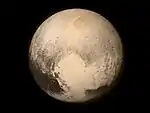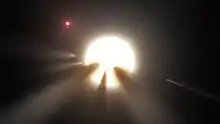K2-22b
K2-22b (also known as EPIC 201637175 b) is an exoplanet 801 ly from Earth, rapidly orbiting the red dwarf K2-22 with an orbital period of 9.145872 hours.[2] It has a mass below 445 Me and a radius below 2.5 Re. The planet was not detected in the K2 photometry. K2 photometry reveals the presence of an anomalous light curve consistent with evaporation of dust from the planet. This dust forms a tail both ahead and behind the planet, similar to some comets in the Solar System.[1] The evaporation of this dust requires a low surface gravity from the host planet, implying it is a low mass, "Mars, Mercury, or even lunar sized bodies with surface gravities of 1/6 to 1/3 that of Earth are to be preferred."[1]
| Discovery[1] | |
|---|---|
| Discovery site | Kepler Space Observatory |
| Discovery date | 2015 |
| Transit | |
| Orbital characteristics | |
| 0.0088 AU (1,320,000 km) | |
| Eccentricity | null[2] |
| 0.381078[2] d | |
| Inclination | null[2] |
| Star | K2-22 |
| Physical characteristics | |
Mean radius | < 2.5±0.4[2] R⊕ |
| Mass | < 445[2] M⊕ |
| Temperature | 2,100 K (1,830 °C; 3,320 °F) |
The survey in 2020 has failed to validate the existence of the planet, although did not claimed it to be a false positive.[3]
References
- Sanchis-Ojeda, R.; et al. (2015). "The K2-ESPRINT Project I: Discovery of the Disintegrating Rocky Planet K2-22b with a Cometary Head and Leading Tail". The Astrophysical Journal. 812 (2). 112. arXiv:1504.04379. Bibcode:2015ApJ...812..112S. doi:10.1088/0004-637X/812/2/112.
- "K2-22 b CONFIRMED PLANET OVERVIEW PAGE". NASA Exoplanet Archive. Retrieved 2015-10-14.
- Adams, Elisabeth R.; Jackson, Brian; Johnson, Samantha; Ciardi, David R.; Cochran, William D.; Endl, Michael; Everett, Mark E.; Furlan, Elise; Howell, Steve B.; Jayanthi, Prasanna; MacQueen, Phillip J.; Matson, Rachel A.; Partyka-Worley, Ciera; Schlieder, Joshua; Scott, Nicholas J.; Stanton, Sevio M.; Ziegler, Carl (2020), ULTRA SHORT PERIOD PLANETS IN K2 III: NEIGHBORS ARE COMMON WITH 12 NEW MULTI-PLANET SYSTEMS AND 26 NEWLY VALIDATED PLANETS IN CAMPAIGNS 0-8, 10, arXiv:2011.11698
| Preceded by PSR J1719-14 b |
Most dense planet 2015–? |
Succeeded by ? |



